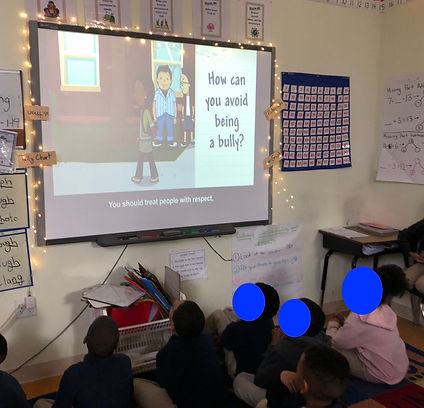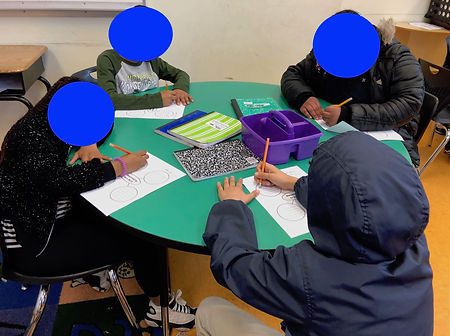Johanna Busch
A Conversation about Bullying
Students demonstrate the ability to speak/write/think about real-world problems.
Bullying is a real-world problem that effects my students on a daily basis. Many of my students have been bullied and some of them have bullied others. Even students who have not personally experienced bullying have family members and close friends who have. There are a few students in the second grade at my schools who have been bullying many students in our grade at recess, lunch, and dismissal. Because of all of this, I wanted to equip my students with the skills that they need to understand and address bullying. Being able to think, speak, and write about bullying will help my students know how to respond when they are confronted with a real-life bullying situation. This will make our school and my students' lives safer.
Bullying Lesson Plan
To help my students think, write, and speak about bullying, I planned a lesson. In this lesson, students first watched a Brain Pop Junior video about bullying. Then, students discussed how they could react when someone is acting like a bully and why people act like bullies. Students then had time to do their own writing about how we can respond to bullies. After that, we listened to a read aloud of The Juice Box Bully by Maria Dismondy. Students created their own bullying promises to help keep our classroom safer. We then combined these promises into a class promise.
This is the lesson plan about bullying I wrote to start a conversation about bullying with my students.
I created a powerpoint to accompany the lesson. This helped provide me with structure as I lead students through discussion questions. It also supported visual learners in accessing information about bullying.
Above is a powerpoint about bullying that I created and used during the lesson about responding to bullies.
Responding to Bullying
After introducing students to the concept of bullying, students watched a Brainpop Junior video about bullying. I often use Brainpop Junior videos to introduce students to new topics. They present high level information in kid friendly language. Additionally, the recurring characters and familiar music engage students and get them excited to learn. My students especially love completing the quizzes after the videos. In this case, I wanted students to be able to articulate what bullying is and how they can respond when they are bullied or see someone being bullied. Watching a Brainpop Junior video was an engaging way of sharing this knowledge.

The image above shows my students watching a Brainpop Junior video about bullying. The full video can be found here.
After watching the Brainpop, I asked students a few questions which they discussed with a partner based on the information from the video. Then, we had a longer discussion about what we learned about responding to bullying from the Brainpop video. Students discussed this in their table groups. Then, students wrote strategies for responding to a bully on individual webs. Finally, we created a class list for ideas for how to respond to bullies. We discussed the pros and cons of each strategy and how we could use them in different situations.

The picture above shows students discussing and writing how they could respond to bullies.

Above is a list of ideas for responding to bullying that students brainstormed after watching the Brainpop video, writing, and talking at their tables.

This student said he could respond to a bully by telling them that they were making him sad.

This student said he could respond to a bully by telling them to stop.

This student said that she could respond to a bully by telling the teacher or another adult.

This student said he could respond to a bully by telling them that they were making him sad.
Above are some student writing samples. Students wrote about how they could respond to a bully.
The Juice Box Bully
After students learned some background knowledge about bullying and had time to discuss how they would respond to a bully, I decided to broaden the conversation into how we can address bullying in our class and school. To do this, I first had students listen to a story called the The Juice Box Bully by Maria Dismondy. In this story, classmates teach Pete about the Promise when he starts to bully others. The Promise helps students treat each other kindly and avoid bullying. After listening to the story, students wrote their own bullying promises, which we hung around the classroom. Then, students engaged in a full class discussion to create our class promise.
Students watched the above read aloud called The Juice Box Bully.

The above picture shows students watching The Juice Box Bully.
After listening to the story, we had a class discussion about how the students in the story created a class environment that discouraged bullying and encouraged friendship. In the story, the class did this by following a promise. We decided that we would come up with a class bullying promise. Students then worked in groups to come up with ideas for promises that would stop bullying in our class. After students had time to work on their own promises, I gathered the class back together to create our own bullying promise to address bullying in our class.

This student promised to help stop bullying by asking the bully to stop nicely.

This student promised to "help the people that is getting bullied."

This student promised to help stop bullying by telling bullies to stop bullying and trying to hurt other people's feelings.

This student promises to tell them what they feel when you bully them.
The pictures above show individual bullying promises that students wrote on juice boxes to hang around the room.

The above picture shows the class bullying promise that students created together. We hung this promise prominently in the classroom to remind students how we should treat others.
Student Reflections
After learning about bullying, watching a video, reading a book, discussing with others, and creating a class bullying promise, students reflected on what they had learned. I asked students to completed written responses about two questions. I then took videos of students sharing where they got they information in their reflections. This shows that students were citing evidence from information that I provided through the Brainpop Junior video and the read aloud.

The image above shows the reflection questions students answered about bullying.




Above are pictures of student reflections about what they learned about bullying.
After I read students reflections, I verbally asked them a few more questions to get a better understanding of what they took away from the information I provided and the discussions our class had about bullying. These videos show my students citing information from the videos we watched in a conversation about a real-world problem. Click the buttons below to watch the videos.
Teacher Reflection
Facilitating this discussion gave my students the knowledge and vocabulary to address a problem that effects our school every day. My students (and their parents) often complained about bullying, but I didn't feel like they had a deep understanding about what bullying is and how we can address it as individuals and a school community. Though we only had this conversation a week ago, I already notice my students using slightly different language when they are having issues with each other. After watching two videos, writing, and talking with each other, my students know a variety of different constructive ways they can respond if someone is being bullied. They also now realize that it is our entire class's responsibility to keep each other safe. I have heard students reference our class promise multiple times in the last couple of days, reminding their classmates that we all need to be kind to each other to prevent bullying. I was very impressed by the interest and excitement my students showed in discussing this real world problem. I hope to continue this conversation with them in the future.